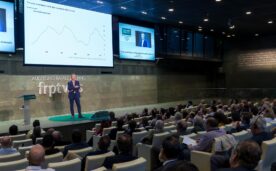How a decade of financial crisis has changed the world
Summary:
On 10 October 2018 took place the Adam Tooze, Kathryn and Shelby Cullom Davis Professor of History lecture at Columbia University, entitled "How a decade of financial crisis has changed the world". Professor Tooze explained that 2008 was the worst global financial crisis in history, including the Great Depression, as shown by the fact that money flows fell from over 30% of GDP to almost 0%. This situation brought the banking systems on both sides of the Atlantic to the brink of collapse. In addition, the US labour market exploded. In the eurozone, credit also collapsed from 2008 onwards and unemployment soared, especially in Spain. This transformed Spanish politics. The shock on both sides of the Atlantic was synchronised and had political consequences for transatlantic relations. It all started with the Wall Street banking crisis, the expansion of which had a lot to do with financial engineering. The banking sector was out of control and fuelled private borrowing, creating the housing bubble, which affected both the lower and upper classes. Mortgage lending skyrocketed, inflating the bubble to the point where 45% of mortgage loans were for housing speculation. In 2008, the Europeans decided that this was an American problem, not theirs, and did nothing about it. In the United States, however, it was a different story. The securitisation of mortgages spread the crisis across the country and then Europe and turned mortgage defaults in the marginal areas where black Americans lived into a global chain reaction. The eurozone had its own debt bubble, possibly bigger than the American one, as well as large real estate bubbles in Spain and Ireland. So if the bubble was global, the crisis would be global. And when it came, it was not the usual shock because capital flows dried up. The recovery started relatively early in the United States and the United Kingdom, but not in the euro area. The same was true for employment developments, especially youth employment. Why? Partly to blame were austerity policies that were synchronised with the financial crisis. Something similar happened in the United States. The difference is that the US authorities immediately started to take measures to stabilise the banking system, while in Europe this was not done, increasing the risk of a credit system collapse. Another European misconception was that Europe was not a land of financial speculation and that the system could not fail because there were no banks large enough for their collapse to be considered a systemic risk. The US response to the crisis was to provide the banks with immediate financial support to recapitalise, support the asset market and carry out monetary and fiscal expansion. Europe should have done the same. Moreover, the United States forced banks to accept these measures in order to build confidence in the financial system. Why was the United States able to do so? First, because of the magnitude of resources that the Treasury was able to mobilise. Key here was the elite that Treasury Secretary Robert Rubin was able to recruit to form his team at the White House, as well as his network of contacts. Moreover, the US authorities exercised both economic and political leadership during the crisis, which was very different from their European counterparts. The US also applied to the financial crisis what it learned from the Vietnam War, namely, to deploy massive forces with nothing and no one to constrain the action. This allowed it to act as a global lender of last resort, which saved the world because credit was not limited to American banks, but also reached European banks, which did not have sufficient dollar collateral to access the Federal Reserve's credit lines. To solve this, the Fed created special swap lines with the European Central Bank. Thanks to these, the ECB received $25 trillion in one lump sum, in exchange for a similar amount in euros. This dollar liquidity was passed on to European banks. The IMF also stepped in, providing liquidity and granting aid to European countries beyond even what they could otherwise obtain on the basis of their quota. Thanks to this umbrella, the United States, the United Kingdom and Switzerland were able to overcome the crisis. The same did not happen in the eurozone, which turned the banking crisis into a sovereign debt crisis. This led to heated discussions among Europeans about what to do about Greece. Fighting the crisis was easier in a nation state, such as the United States, than in the European Union. The European emphasis on austerity, rather than debt restructuring, bank recapitalisation and ECB support, destabilised debt markets and caused the risk premium to reappear.
The Rafael del Pino Foundation is not responsible for the comments, opinions or statements made by the people who participate in its activities and which are expressed as a result of their inalienable right to freedom of expression and under their sole responsibility. The contents included in the summary of this conference are the result of the debates held at the meeting held for this purpose at the Foundation and are the responsibility of their authors.
The Rafael del Pino Foundation is not responsible for any comments, opinions or statements made by third parties. In this respect, the FRP is not obliged to monitor the views expressed by such third parties who participate in its activities and which are expressed as a result of their inalienable right to freedom of expression and under their own responsibility. The contents included in the summary of this conference are the result of the discussions that took place during the conference organised for this purpose at the Foundation and are the sole responsibility of its authors.









